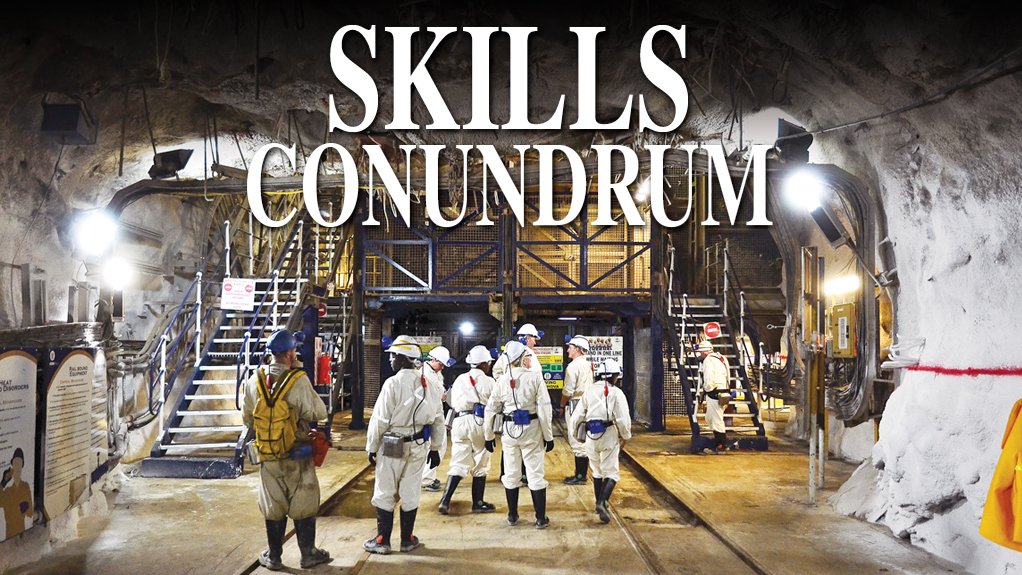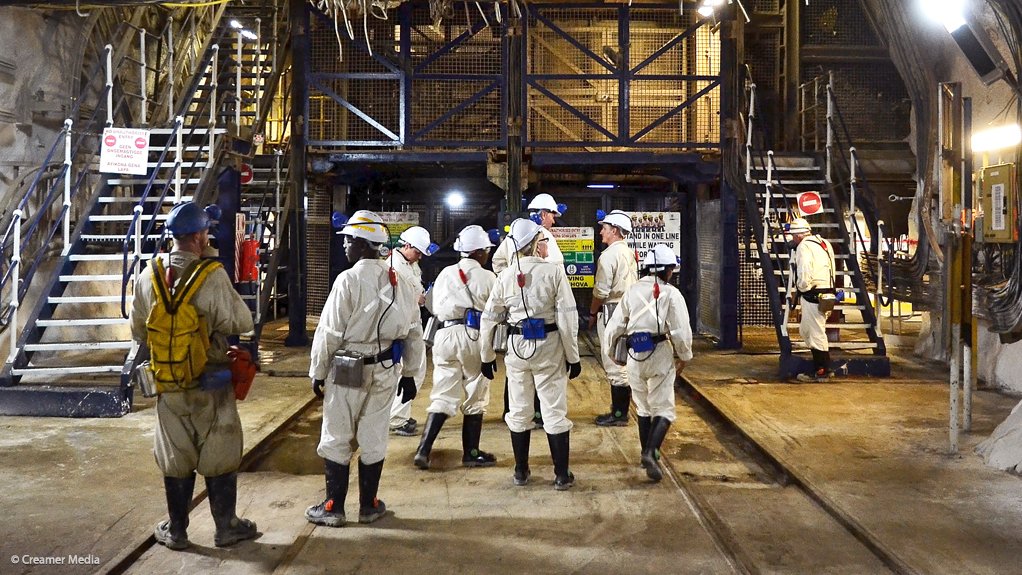SA mines relying heavily on unskilled workers despite Industry 4.0 gaining traction





The current state of the South African mining sector points to a significant reliance on unskilled labour
Photo by Dylan Slater
MARITHA ERASMUS An increase in the employment of general workers is unexpected because the consensus would be that, as mines become more modernised, so would the employment of a more skilled workforce
Photo by Dylan Slater
MUSTAK ALLY Until recently, the basic requirements for entering the mining industry were gross motor skills, but what is required currently is well-developed fine motor skills
Photo by Dylan Slater
Contrary to the expectation that it would move towards employing a higher number of skilled personnel to catalyse modernisation and mechanisation targets, the South African mining industry has backtracked, employing a significant number of unskilled personnel instead, according to a report compiled by Africa-focused research and analysis organisation In On Africa and human resource advisory firm Managing Transformation Solutions (MTS Holdings).
The ‘Mining Trends Report 2018’ was released last month to highlight the effectiveness of education and training in the local mining sector. The sample analysed comprises more than 12 000 people from more than 45 mining and core contractor companies.
A general decline in the local mining industry has been blamed on the slow adoption of mechanised mining methods and the reluctance to extensively modernise operations using technologies such as automation, artificial intelligence (AI) and remote control.
The move away from upskilling mining personnel and relying instead on a greater number of unskilled and low-skilled personnel contrasts with a global call for greater emphasis on upskilling workforces as the Fourth Industrial Revolution, or Industry 4.0, gains traction.
A major component of Industry 4.0 involves mechanisation, modernisation and digitalisation, with machines and AI the driving force behind highly efficient and safer methods for industry, mining, processing and manufacturing.
Any form of modernisation would require a larger number of mining personnel to be highly skilled to operate and maintain intelligent machinery, which, in turn, will likely be deployed in deeper, hotter and more unsafe depths to find previously unattainable orebodies.
With a paradigm shift in terms of how operations are conducted comes a shift in how personnel work and are trained. Minerals Council South Africa (MCSA) skills development head Mustak Ally points out that, previously, the basic requirements for entering the mining industry were “gross motor skills”, but what is required currently is well developed fine motor skills.
However, he also points out that it might prove difficult to teach some of the older generation of miners fine motor skills, which could be done through, for instance, playing video games.
Many commentators in the mining industry have emphasised that it stands to benefit much from mechanisation and modernisation, with machines taking over dangerous tasks and removing people from labour-intensive and unsafe conditions. This would go a long way towards improving safety for miners and mitigating the high number of injuries and workplace-induced illnesses.
The report states that a greater number of people who have a higher degree of knowledge and skills would need to enter the industry to catalyse a new wave of industrial growth, which would seemingly also require the mining industry to follow suit in terms of employing such people and upskilling existing personnel to ensure a new prosperous, more efficient and safer local mining industry.
Low-Skills Concentration
However, the report points out that, within its control group, a significantly greater number of unskilled or low-skilled people have been employed. This is evident through the number of general workers rising from 7% in 2012 to 21% in 2017.
General workers also occupy the number one position in the top ten core mining positions at local mines, epitomising the greater employment of unskilled personnel. The other core mining positions in 2017 were winch drivers (18%), rigid dump truck operators (15%), dump truck operators (11%), team leaders (8%), process operators (8%), learners (6%), artisans (5%), boilermakers (4%) and drill rig operators (4%).
These positions also accounted for 40% of all mining staff in 2017, a vast increase from the 27% noted in 2012.
MTS Holdings CEO Maritha Erasmus describes the increase in the number of general workers as “completely unexpected” because the consensus would be that, as mines become more modernised, so would the employment of a more skilled workforce.
She also points out the relevance and importance of the mining sector in terms of being a key employer of vulnerable groups of people, and failure to upskill vulnerable people reflects poorly on expanding the country’s skills set.
In 2012, the top core mining position was that of a rigid dump truck operator, with 22% representation, but this dropped to third place in 2017, with 15% representation.
The report also reveals that, during the 2012 to 2017 review period, representation of the top ten core mining positions has shown a significant increase from 18% in 2012 to 40% in 2017, suggesting that a concentration of skills in core mining positions has occurred.
In terms of education development, enrolment for general education and training (GET) for men decreased from 22% in 2012 to 14% in 2017, while enrolment for further education and training (FET) increased from 70% to 75% during the period. Higher education and training (HET) enrolment also increased from 8% to 11%.
For women, GET enrolment increased from 7% in 2012 to 9% in 2017, while FET enrolment shrank from 83% to 77% and HET enrolment expanded from 11% to 14%.
Women and Youth Representation
The number of women working at mines increased by 3% from 2012 to 20% overall in 2017.
In terms of women in the top ten core mining positions, there has been an increase of 3%, from 11% in 2012 to 14% in 2017.
However, when considering historical positions in which women were most likely to be employed, Erasmus says representation has actually decreased. In 2017, women were clustered into low-skilled positions such as general workers. Ninety-five per cent of all women in core positions were employed in the top ten core positions in 2017, with few women employed in higher-level, management-type positions.
In order of representation, the top ten core positions for women in the report sample are general workers (20%), learners (13%), winch drivers (12%), assistant drill rig operators (11%), blasting assistants (10%), process operators (9%), process attendants (8%), dump truck operators (7%), weigh bridge clerks (6%) and rigid dump truck operators (4%).
However, although women representation has increased, the volumes of younger people employed have declined, from 66% in 2012 to 60% in 2017.
The mining industry also needs to address what the report describes as the stagnation of progressing equal gender representation and distribution, as the promotion of women overall within the sample increased from 17% in 2012 to only 20% in 2017. Within the top ten core positions, women accounted for 11% of workers in 2012 and 14% in 2017. This trend needs to be addressed by increasing the appointment of women in other positions and their acquisition of more technical skills competences.
Going Forward
The report states that, for the mining industry to progress and modernise, it needs to employ more workers who have higher qualifications and more skills to enable the sector to transition away from its current labour-intensive operations.
Ally also points out that the MCSA is assessing employment equity data from recent years to gain a better understanding of which mining companies are modernising and how their workforce structures are evolving in line with new operating structures.
He explains that the council is also assessing the rate of change at the various job-category levels: “If we understand the rate of change in the specific job categories . . . we will then be able to determine which sectors are modernising faster than others and map what those organisational structures will look like.”
This will, consequently, allow for a greater understanding of how such companies are evolving and in which Paterson levels of skills grading employment is taking place and where it is decreasing, he adds.
In this regard, more emphasis needs to be placed on upskilling existing employees, although the report also states that they should be employing people with higher levels of education and skills faster than the current rate.
Comments
Press Office
Announcements
What's On
Subscribe to improve your user experience...
Option 1 (equivalent of R125 a month):
Receive a weekly copy of Creamer Media's Engineering News & Mining Weekly magazine
(print copy for those in South Africa and e-magazine for those outside of South Africa)
Receive daily email newsletters
Access to full search results
Access archive of magazine back copies
Access to Projects in Progress
Access to ONE Research Report of your choice in PDF format
Option 2 (equivalent of R375 a month):
All benefits from Option 1
PLUS
Access to Creamer Media's Research Channel Africa for ALL Research Reports, in PDF format, on various industrial and mining sectors
including Electricity; Water; Energy Transition; Hydrogen; Roads, Rail and Ports; Coal; Gold; Platinum; Battery Metals; etc.
Already a subscriber?
Forgotten your password?
Receive weekly copy of Creamer Media's Engineering News & Mining Weekly magazine (print copy for those in South Africa and e-magazine for those outside of South Africa)
➕
Recieve daily email newsletters
➕
Access to full search results
➕
Access archive of magazine back copies
➕
Access to Projects in Progress
➕
Access to ONE Research Report of your choice in PDF format
RESEARCH CHANNEL AFRICA
R4500 (equivalent of R375 a month)
SUBSCRIBEAll benefits from Option 1
➕
Access to Creamer Media's Research Channel Africa for ALL Research Reports on various industrial and mining sectors, in PDF format, including on:
Electricity
➕
Water
➕
Energy Transition
➕
Hydrogen
➕
Roads, Rail and Ports
➕
Coal
➕
Gold
➕
Platinum
➕
Battery Metals
➕
etc.
Receive all benefits from Option 1 or Option 2 delivered to numerous people at your company
➕
Multiple User names and Passwords for simultaneous log-ins
➕
Intranet integration access to all in your organisation






















